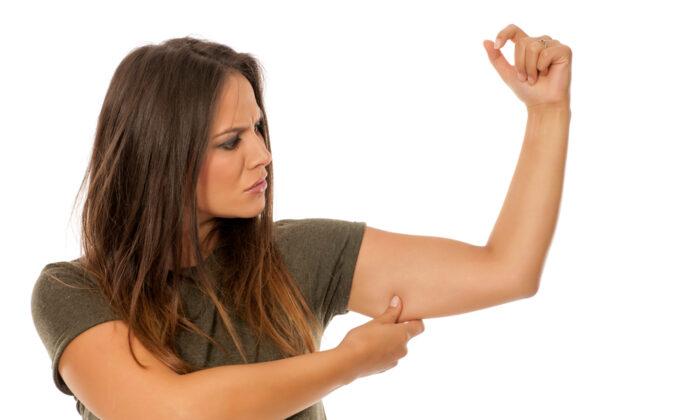Aging hair follicles result in a shorter life cycle, leading to hair loss. The hair that is replaced usually tends to be finer. Post-menopausal women often report thinning hair, usually caused by a decrease in female sex hormones like estrogen. The reduction of these hormones causes some hair follicles to stop producing new hair, resulting in the appearance of thinning hair.
As we age, our hair starts turning grey. Most people reach for a bottle of hair dye; however, you should try to avoid coloring your hair too often as the chemicals inside the dye can further damage fine hair. Other causes of hair loss may include thyroid issues and nutritional deficiencies.
Boost Hair Growth and Strengthen Your Hair Follicles
Whether you’re pre- or post-menopause, you want to make sure you adopt healthy life habits to ensure your hair follicles receive the best possible care, says dermatologist Dr. Wilma Bergfield. This can involve eating more nutritious food such as high amounts of protein like fish and some red meat. These foods boost your levels of omega-3 and iron, which are both vital ingredients for promoting hair growth.Increase Protein
A lack of protein has been associated with hair loss. Hair follicles are made from a protein called keratin, so it only makes sense to consume more protein-rich food to boost nutrient intake and help repair damaged follicles. Try consuming more fatty fish like salmon, herring, and mackerel. These fish are rich sources of omega-3, which has been linked to boosting hair growth and thickness. Fatty fish are also full of EPA and DHA—fatty acids that help improve brain, eye, and heart health.Consume More Dark, Leafy Greens
As we get older, vegetables should become an even more important part of our diet. Spinach is a great vegetable choice for combatting thin, brittle hair and boosting hair growth. It is full of beneficial nutrients: including folate, iron, and vitamins A and C. Kale and collard greens are also good sources of these nutrients. The combination of these vitamins results in strong, healthy hair.Fruits and Berries
Try consuming more fruits and berries rich in vitamin C, and antioxidants like blueberries, raspberries, cranberries, oranges, cherries, and other fruits. These kinds of food are great for boosting collagen in your body, which in turn produces hair-building proteins.Eat More Nuts and Seeds
Nuts are packed with proteins, healthy fats, vitamins, and minerals that do miracles for the mind and body. They’re also great for preventing hair loss and promoting strong, healthy hair growth. Brazil nuts are rich sources of selenium, a mineral that promotes hair growth, making them a perfect choice for older people with thin, brittle hair. Consuming just four Brazil nuts a day provides your daily dose of selenium, according to celebrity nutritionist, Nmami Agarwal. Other healthy nut options include walnuts, almonds, flax seeds (needs to be ground in order to get the maximum nutritional benefit), and chia seeds.Use Natural, High Quality Hair Products
Try to avoid chemical-ridden hair products that contain phthalates, sulfates, and parabens as they increase the likelihood of developing cancer and interfere with your body’s normal hormone production. Some studies have even found a link between parabens and scalp irritation leading to eventual hair loss, as the chemical is easily absorbed through the skin. Staying away from sulfates is a good idea as too much of it can strip your scalp and hair of natural oils leading to hair loss.DIY Shampoo Recipe
This recipe is great for normal hair types. It incorporates carrot seed essential oil which has great antifungal properties and improves circulation, boosting hair growth.Ingredients:
• Liquid castile soap (half a cup)• Maple syrup (2 tablespoons)
• Carrot seed essential oil (five to 10 drops)
• Castor oil (10 drops)
Simply mix all ingredients in a container and store in a bottle for easy use. Pour over wet hair and massage into the scalp for a couple of minutes, then rinse out. According to Hairguard, the maple syrup is very nourishing for hair, and it also has antibacterial properties.
If you have dry and brittle hair, this recipe recommends the same amount of liquid castile soap along with half a cup of water, a third of a cup of aloe vera gel, a teaspoon of olive oil, two to three teaspoons of almond oil, and finally 10 drops of geranium essential oil.
Avoid Flat Irons and Blow Dryers
Using heat on dry, brittle hair can add further damage your thin hair, leading to increased hair loss. Try to avoid frequent use of flat irons as the high temperature can severely damage your hair. Air drying is a gentler way of letting your hair dry. If you must use blow dryers or flat irons, make sure you buy a styling spray or heat protectant to apply to your hair first as this will minimize the damage and create a protective barrier.Minimize Exposure to Ammonia and Peroxide
Many people wish to color treat their hair to cover their grey. Try to opt out of using harsh permanent hair colorants containing ammonia and peroxide as these are overly drying and damaging to thin, brittle hair. Semi-permanent color often contains neither of these ingredients, making it a safer alternative than permanent hair color as it doesn’t alter the hair shaft but still offers color. The color may fade after four to 12 washes, but it is much gentler on the hair. You can even choose semi-permanent silver shades to blend in with your natural greys to create definition and shine.Using henna has many benefits as it helps strengthen the hair follicles, prevents hair thinning and excessive hair loss, and boosts the hair’s shine and lustre. It’s also considered a permanent hair colorant, which makes it a great alternative to chemical box dyes for covering greying hair. Henna tints hair an orange to red color, but it can be mixed with other natural dyes like indigo to achieve a darker shade. If you add a little bit of amla powder to your henna-indigo mix, the mixture will work as a natural toner, removing any brassy tones and creating a natural, cool brunette shade.
Try New Hair Styles and Embrace Your Silver Strands
Greying hair is a natural phenomenon. Try to change your perspective and embrace it rather than hiding it with damaging hair products. There are many fashionable styles that will help enhance your silver strands while making you appear soft and youthful.Taking Care of Grey Hair
Grey hair tends to grow coarser and drier, so try to stick to hydrating shampoos to boost moisture in your hair. If you often have very dry hair, it may be caused by chemicals present in everyday hair products, leading to changes in hair pH levels. If you’re looking for a simple yet effective way of reintroducing moisture in your hair, try doing an apple cider vinegar rinse. Apple cider vinegar is one of those staple ingredients found in most households.If you live in a place with hard water, chances are that is what’s contributing to your dry hair as it’s changing your hair’s pH. Using apple cider vinegar helps rebalance it, decreases frizz, removes product build-up, and adds shine. It’s even believed to help with hair growth!
Some people enjoy wearing a silk cap to bed after their apple cider vinegar rinse as it helps hair feel sleek and glossy. If you’re particularly sensitive to the smell of apple cider vinegar, you can add a few drops of your favorite essential oil—like lavender or rosemary—to mask the unpleasant scent.
Another way to look after your silver tresses is to avoid excessive sun damage caused by UV rays. Greying hair lacks color pigments, making it more susceptible to sun damage than darker hair. Using a UV hair protectant on your hair can offer some protection.
Finally, consider investing in a water filter for your shower. This will remove harsh and drying contaminants—like chlorine, fluoride, lead, and other chemicals present in water—leading to cleaner, healthier hair that is less prone to breakage.
Follow the nutritional and hair care tips above to strengthen your hair follicles and put an end to thinning hair!





